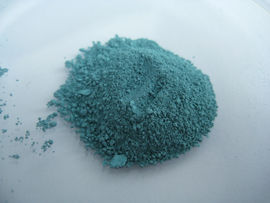Copper(II) hydroxide

| |
| Names | |
|---|---|
| IUPAC name
Copper(II) hydroxide
| |
| Other names
Copper dihydroxide
Cupric hydroxide | |
| Properties | |
| Cu(OH)2 | |
| Molar mass | 97.561 g/mol |
| Appearance | Blue solid |
| Odor | Odorless |
| Density | 3.368 g/cm3 |
| Melting point | 80 °C (176 °F; 353 K) (decomposes to CuO) |
| Boiling point | Decomposes |
| Almost insoluble | |
| Solubility | Reacts with acids, bases, halogens, SO2 Insoluble in organic solvents |
| Vapor pressure | ~0 mmHg |
| Thermochemistry | |
| Std molar
entropy (S |
108 J·mol−1·K−1 |
| Std enthalpy of
formation (ΔfH |
−450 kJ/mol |
| Hazards | |
| Safety data sheet | Sigma-Aldrich |
| Flash point | Non-flammable |
| Lethal dose or concentration (LD, LC): | |
| LD50 (Median dose)
|
1000 mg/kg (rat, oral) |
| Related compounds | |
| Related compounds
|
Copper(II) oxide |
| Except where otherwise noted, data are given for materials in their standard state (at 25 °C [77 °F], 100 kPa). | |
| Infobox references | |
Copper (II) hydroxide is the inorganic compound with chemical formula Cu(OH)2. It is more reactive than copper(II) carbonate or copper(II) oxide, making it a preferred starting point for other copper compounds.
Contents
Properties
Chemical
Copper(II) hydroxide is an reactive hydroxide of copper. It can be converted to other copper compounds by acidification.
- Cu(OH)2 + HX → CuX + 2 H2O
Depending on how it was made, a sample of copper(II) hydroxide may readily absorb carbon dioxide from the air, converting to copper(II) carbonate, or give off water, dehydrating to copper(II) oxide. The latter occurs more readily in basic conditions. If properly dried, however, it reacts much less easily with its surroundings.
Physical
The appearance of copper(II) hydroxide can vary enormously depending on the route of its preparation. It varies in consistency from voluminous and gelatinous or waxy when freshly precipitated to a chalky powder when dried. It can vary in color from a pale blue to more intense blue hues, but the most commonly encountered colors are dingy blue-green or blue-gray, often as a result of the presence of other copper compounds produced by reaction with the atmosphere.
Availability
Copper hydroxide can be purchased as fungicide. It is also sold by many chemical suppliers.
Preparation
Copper(II) hydroxide can be made by adding very dilute sodium hydroxide to a soluble copper(II) salt, and not the other way around. The hydroxide precipitates, with the best samples precipitating in colder solutions. In excessively basic conditions, the hydroxide formed will rapidly convert to copper(II) oxide, which is exacerbated by heating.
If aqueous ammonia is used instead of sodium hydroxide, the copper(II) hydroxide precipitated has much greater air stability, but if excess ammonia is added, the hydroxide will begin to dissolve, forming the deep blue tetraammine copper(II) complex. A diluted solution of sodium hydroxide is then added to precipitate the copper(II) hydroxide from the solution, and this route has the advantage of preventing local hotspots which cause the formation of copper(II) oxide.[1]
Very pure copper hydroxide can also be made via electrolysis of water with a copper anode, containing small amounts of sodium sulfate.[2]
Projects
- Make copper(II) oxide
- Make Schweizer's reagent
Handling
Safety
Copper hydroxide is mostly safe, but oral and skin exposure should be limited when wet, as it is sparingly soluble, and the general trend among soluble copper compounds is that they act as irritants and are mildly toxic. Dilute hydrochloric acid in the stomach may react with copper(II) hydroxide to form copper(II) chloride, which is more of a concern.
Storage
Dry copper hydroxide should be stored in closed plastic bottles.
Disposal
Copper hydroxide can be reduced to elemental copper.